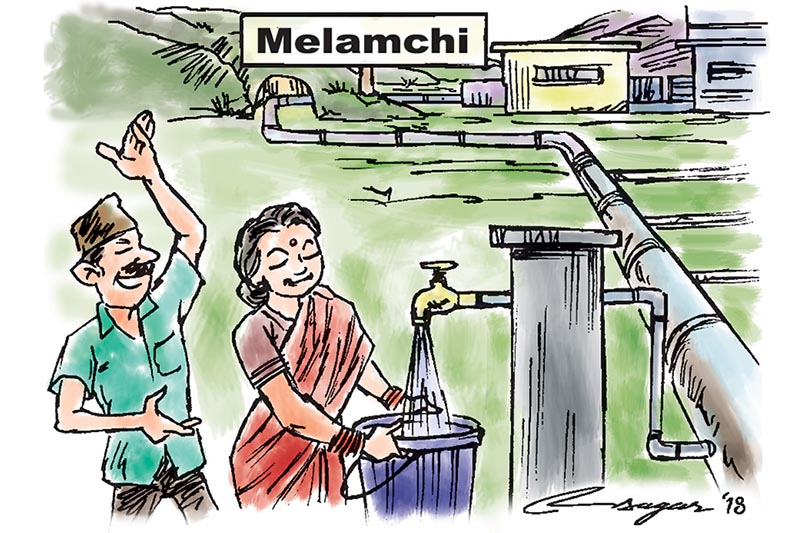Melamchi water: Not a pipedream now
The project will initially supply 170 million litres of water from Melamchi River to the Valley in the first phase. In the second phase, water from Yangri and Larke rivers will be diverted to Melamchi River to supply an additional 340 million litres of water
Kathmandu has been waiting for years for water from the Melamchi River in Sindhupalchowk to arrive. Water from Melamchi arguably has been one of the most talked about issues the last two decades. If recent reports are anything to go by, Kathmandu denizens are all set to get water from the Melamchi River to quench their thirst very soon. Out of the total 27.58-kilometre tunnel required to be built from Ambathan, the origin site of the Melamchi river near Helambu, to Sundarijal in Kathmandu, works on over 25 kilometres have been completed.
Billions of rupees have been spent on the Melamchi water project since the inception of the master plan in 1988. Its third deadline expired in October this year. The first deadline expired in 2007 and the second in 2016. Started on December 21, 2000, the Melamchi Water Supply Project (MWSP), as it is officially called, is assisted by the Asian development Bank (ADB).
The MWSP is a national pride project which aims to address the water woes of the Kathmandu Valley. Given the abundance of water in the Melamchi river, the project is thought to be the best solution to address the Capital city’s perennial water problem.
However, the pace of works over the years has been so slow that Kathmandu residents have more than on one occasion doubted the project would ever complete, wondering whether it would remain only a pipedream. Geological barrier is believed to be the main hurdle in tunnel excavation work. Given the current rate of tunnel excavation, it may still take four to six months to complete the works. Till date, billions of rupees and human efforts have been applied to accomplish the gigantic task of diverting water from the Melamchi river to the Kathmandu Valley.
But now there seems to be light at the end of the tunnel, as tunnel construction works have moved forward comparatively at a faster pace in recent months. A few months ago the construction of the project was halted due to some disputes between the contractor and local construction workers. Construction, however, has resumed and it is believed that the project would be completed at the earliest.
According to reports, workers now are in the final leg of tunnel excavation, with only around 143-metre section remaining. This means 99 per cent of tunnel works have been completed so far.
It, however, will take some more months before Kathmandu denizens get water from Melamchi. According to reports, three ventilation shafts, which are drilled through vertical plain above the tunnel, are yet to be built. Ventilation shafts are built for the purpose of maintaining air pressure inside the tunnel. Similarly, construction of headworks, diversion weir, intake structure and desiccating basin to filter the water before being supplied to the tunnels are yet to be built. It will then take another three months to check the entire distribution system.
The MWSP will initially supply 170 million litres of water from the Melamchi river to the Valley in the first phase. In the second phase, water from Yangri and Larke rivers will be diverted to the Melamchi river to supply an additional 340 million litres of water
In this way, the total supply of water from the three rivers to Kathmandu will be 510 million litres per day.
Currently, the Kathmandu Upatyaka Khanepani Limited (KUKL) is the sole semi-government utility that supplies water to the denizens of the Capital city. According to estimates, daily drinking water demand of Kathmandu stands at 370 million litres. But the KUKL has been able to supply only around 110 million litres of water. The gap between supply and demand of drinking water in the Kathmandu Valley is huge. Of the 110 million litres of water supplied to Kathmandu denizens every day, the KUKL admits that there is a leakage of 30 to 40 per cent due to age-old supply lines, most of which were laid during the Rana regime.
The KUKL collects 65 per cent of its water from surface source and the rest 35 per cent from ground water source. The Kathmandu Valley has seen rapid population growth in recent years and water from Melamchi can only suffice the drinking water need of people.
Melamchi is a snow-fed river situated at high altitude of Langtang Himalayan range. The geological profile of the Melamchi river clearly indicates that the water flows on the basis of gravitational force. So earlier, there was an initial plan of construction of a 25 megawatt hydropower plant along with the water supply project. But it’s an irony that the MWSP has now dropped the idea. It is not clear why this plan was dropped. The government should not leave the hydel project plan, as it would mean drinking water as well as electricity from the same source.
Nonetheless, as the project nears completion there are some concerns that arise from climate change impacts. Reports suggest our Himalayas too have been affected by climate change. This, however, should not be an excuse to delay or drop the project. Water from Melamchi is the only viable option as of now to quench the thirst of Kathmandu people.
This priority project must be completed at any cost – and at the earliest. There could be various other options when it comes to bringing drinking water to Kathmandu, but as of now water from the Melamchi river seems to the most reliable solution to Kathmandu’s perennial water crisis.






